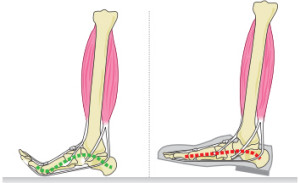OrtoMalli Step – For optimal motion
Studies carried out on the way people walk and the footwear industry, in particular, consider walking with heel-first steps to be part of a normal physiological kinetic chain. Heel-first stepping should not always be considered a part of an optimal kinetic chain. For example, when walking uphill barefoot (or wearing shoes without heels), the contact of the heel with the surface is reduced or completely eliminated. On a steep uphill, the functioning of the foot (including an over-pronated foot) is optimal, provided that the muscles are in good shape. Excessive support provided by footwear on the foot prevents the foot from moving in the way evolution originally intended.
It is clear that wearing shoes that are too comfortable, directing the wearer to only use some of their muscle groups, results in arthrosis, over-pronation, stress injuries and more.
Unfortunately, the modern human walks exactly like that, with the heel first, due to footwear. In heel-first stepping, shock absorption is not sufficient in the actual pronation stage (the ankle rolling inward). Heel-first stepping also fails to pre-tense the foot to prevent problems caused by over-pronation (a low arch).
We must look at the problem from the point of view of anatomy and analyse the action of the foot inside the shoe during stepping, and compare it to what happens in a shoeless step formed by evolution— the kind of a step that we had 10,000 to 20,000 years ago. An over-pronated foot should be exercised with both an OrtoMalli insole and the kind of a step evolution intended, so that the muscles of the foot and the insole would provide support for the step.
A step in accordance with OrtoMalli Step is similar to our ancestors’ steps. Clearly, we need to protect the toes by flexing them up to prevent injuries when running fast on uneven terrain. The principle of the OrtoMalli step is to use the ball of the foot powerfully in every phase of the step, and the foot makes contact with the surface.

A free activated foot | A passive foot in a tight shoe.
An OrtoMalli Step exercise:
I. The ball of the foot makes contact with the surface with toes flexed up.
- This way the flexor muscles of the sole of the foot, toes and ankle are maximally activated as the ball of the foot makes contact with the surface.
- In this position, it is almost impossible to strain the ankle since the supporting tension of the muscles is so strong that it locks the ankle to an optimal supination/pronation position.
- The tension of the muscles keeps the ankle locked in the correct position, ensuring that the ankle will not over-pronate or the foot will not become flat. This action is maximally supported by the dynamic directions and anatomy of the ankle and foot flexors.
- A shock is evenly distributed over a physiologically correct kinetic chain of the foot and is completely absorbed as it reaches the back area. This way the step is closer to the body and the knee is slightly bent. Both the step and balance can be controlled. In addition, the information gained from the ball of the foot and toes helps control the movement of the body on, for example, slippery surfaces.
- Tension on the calf muscles is slightly stronger and longer in duration during this kind of a step, and the mechanical pressure on the veins increases circulation. Thus, it is said that the calf muscles are the second pump in the human body.
II. As the weight of the body moves over the foot, the toes straighten.
- The entire sole makes contact with the surface but the ball of the foot area has the strongest contact. The contact with the surface and information gained from it (surface contour, slipperiness) is transmitted to the brain before the weight is on the foot completely.
- A pre-tensed ankle stays in the correct pronated position effortlessly. The positions of the calf and knee are optimal. When ancient humans walked barefoot on soft terrain, the toes were flexed up longer, contributing to proper pre-tension.
III. In the thrusting phase, the ankle and knee straighten effectively.
- When the ankle is in the optimal position throughout the entire step, the power of the thrust is maximal and extends from the hip area to the back and further all the way to the neck through the correct kinetic chain. The calf muscles and the Achilles tendon are aligned. The correct position of the leg does not put a strain on the knee area.
A step in accordance with OrtoMalli Step is identical to the steps of our ancestors. Walking or running fast in a forest was not possible with toes straight but the toes needed to be flexed intensively up in order to prevent injuries. This movement (extension) tightens the toe flexors and calf muscles, making it, for example, impossible to strain one’s ankle. This is the most natural way of stepping for the human anatomy. Wearing the correct kind of shoes and moulded OrtoMalli insoles as well as performing the aforementioned exercise effectively prevent over-pronation and development of a flat foot.



